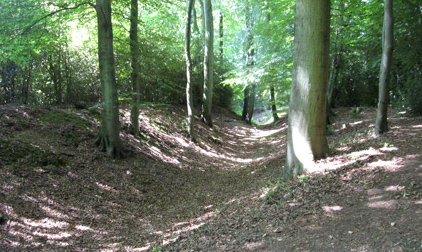The Chilterns have a number of sites of great archaeological interest.

The North Chilterns is the location of several interesting iron age hill forts, the best preserved of which is Cholesbury Camp.
Important early trade routes from East Anglia across towards Wiltshire required protection and these hill forts make the most of the natural advantage of the Chilterns high ground.
Cholesbury Camp, in the village of Cholesbury Buckinghamshire, once a relatively isolated settlement, is today easily reached by a footpath at the side of Cholesbury Village Hall.
What can be seen today is an impressive circular ditch which would have had fortified ramparts on either side of its remarkably steep inner and outer banks.
The Camp is thought to have originally had two entrances, have been heavily fortified and occupied principally during times of threat or siege.
Archaeological studies have found evidence at Cholesbury Camp of hearths, fires and clay-lined ovens consistent with iron age settlement.
A visit to Cholesbury Camp can be combined with visits to the sites of other prominent iron age hillforts along the Chiltern escarpment such as those nearby at Boddington Hill near Wendover and Beacon Hill above Ivinghoe.
Cholesbury village itself has two ponds which would have provided a reliable source of water. Grazing of sheep and cattle would have thrived through the Middle Ages, a legacy of which survives today with Cholesbury Common.
Evidence of the Roman occupation of the Chilterns survives today in the form of Akeman Street and Watling Street as well as the sites of several Roman villas for example on the edge of old Amersham and near Tring Station.
Medieval field patterns are still clearly seen in the Strip Lynchett field system at the eastern end of the Chilterns in the Barton Hills.
